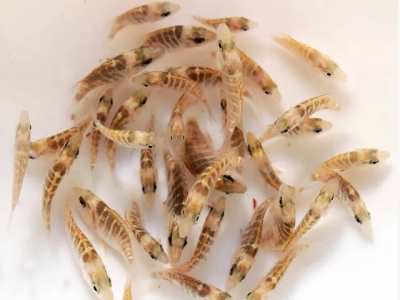Indian scientists report red snapper breeding breakthrough

The breeding cycle of the red snapper (Lutjanus argentemaculatus) has been closed following a five year breeding programme by the ICAR-Central Institute of Brackishwater Aquaculture (CIBA), who have hailed it as “a major boost to diversification of brackishwater aquaculture in the country”.
Hathery produced red snapper juveniles. Photo: ICAR-CIBA
CIBA says that this breakthrough with “help solve a major issue of lack of hatchery produced quality seeds in consistent basis in aquaculture of red snapper and would open up enormous scope for the country’s brackishwater aquaculture ventures in near future”.
Red snapper is highly valued in India, fetching a price of between Rs.400 to Rs.600/kg. Locally known as Seppili (in Tamil) and Chembally (in Malayalam), CIBA says that the species has “immense potential for brackishwater aquaculture, owing to its fast growth rate, easy adaptability to culture conditions, quick acceptance of artificial feed, pleasant appearance and good meat quality”.
“It is an ideal candidate species suitable for different rearing systems such as ponds, pens and cages. This species which readily accepts formulated feed can grow to marketable size of 300-500 g in less than six months, making this fish a farmer’s choice,” they add.
CIBA has previously developed breeding programmes for sea bass, milkfish and grey mullet.
“With this achievement, the CIBA has introduced one more candidate species for brackishwater aquaculture diversification and sustainability,” said Dr K K Vijayan, director of CIBA. “Now, the fish farmers have diversified options to choose their candidate species for aquaculture. The feat will help increase the domestic production through brackishwater aquaculture in the country.”
The first batch of snapper fingerlings bred by CIBA was distributed to selected fish farmers from Tamil Nadu and Kerala.
“The farmers will grow the fingerlings at their respective farms and will return the selected broodstock to the CIBA on a buy-back mode for further breeding in the hatchery,” said Dr M Kailasam, who led the team of researchers to develop the technology. He hoped that private players would come forward to adopt this hatchery technology so that seed production could be scaled up.
Có thể bạn quan tâm
 Converting airline food waste into aquafeeds
Converting airline food waste into aquafeeds Plans to produce insect protein for the aquafeed sector from discarded airline food have been announced in Singapore today.
 The app that's set to improve the profitability of crab farming in the Philippines
The app that's set to improve the profitability of crab farming in the Philippines A group of researchers in the Philippines is looking to develop and commercialise an app that helps farmers differentiate between three very closely connected
 Lessons from China - the home of integrated aquaculture
Lessons from China - the home of integrated aquaculture Phrase integrated multi-trophic aquaculture (IMTA) it is the Chinese who have been at the forefront of developing – and adopting –practical forms of polyculture